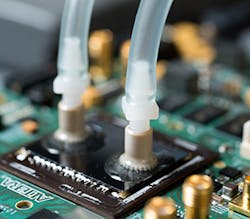Researchers Move Liquid Cooling Up Against FPGA Chips
With computer chips growing more powerful, there is significant demand for advanced cooling systems that can dissipate the large amounts of heat produced by ultrafast processors. Now, a research team from the Georgia Institute of Technology has found a method to move liquid cooling directly onto the chip, carving trenches into the backside of field-programmable gate arrays (FPGAs).
The research team began with stock 28-nm Altera FPGA chips, removing the heat sink and heat spreading materials. The researchers etched cooling passages into the silicon, incorporating silicon cylinders approximately 100 µ in diameter to improve heat transmission into the liquid. Next, a silicon layer was placed over the microfluidic passages and ports were attached for the water tubes, which pumped deionized water over the chip.
The new technology could make it possible for engineers to create more powerful electronics that would no longer require heat sinks or cooling fans on top of computer processors. The research showed that FPGA processors employing Georgia Tech’s cooling system operated at a temperature less than 24°C, while a standard air-cooled processor operated at around 60°C. Lower operating temperatures can translate to more processing power, longer device life, and greater energy efficiency.
The shift toward smaller and smaller transistors etched into silicon chips has presented a significant problem to semiconductor engineers. With faster switching speeds and more processing power, computer chips will generate greater amounts of heat. As transistors generate more heat, they become more prone to losing energy through current leakage.
While the experiments tested FPGA chips, the research team noted that the same liquid cooling technology could be used in other computer processors, graphical processors, and power amplifiers, among other devices. In addition, the system could reduce hotspots in circuits by applying liquid cooling closer to the power source. Eliminating the need for heat sinks could also lead to more compact device packaging.
Liquid cooling is a field of research that has grown as computer processors consume more power and generate more heat, according to Muhannad Bakir, an associate professor in the Georgia Tech School of Electrical and Computer Engineering and one of the head researchers. Existing cooling technology remains largely bound to air-cooled heat sinks and cold plates attached to fully-packaged silicon chips.
While existing technology adds thermal resistance and reduces waste heat, Bakir notes that liquid cooling could make it possible to do things with processors that were previously considered extremely difficult. “[This research] may open the door to stacking multiple chips, potentially multiple FGPA chips or FPGA chips with other chips that are high in power consumption,” he says.
Bakir’s research team has already made progress toward stacking multiple FPGA chips. In another research project, the researchers developed copper vias that would run through the silicon columns that are part of the cooling structure. With a high aspect ratio, the copper vias reduce the capacitance of the connections that would carry signals between chips in a stack. The result, Bakir says, is reduced interconnect length and higher computation bandwidth.
The cooling research was supported by the Microsystems Technology Office of the Defense Advanced Research Projects Agency (DARPA). It was funded through the agency’s Intrachip/Interchip Enhanced Cooling (ICECOOL) program, which examines the capabilities of “embedded” thermal management and putting liquid cooling directly on the silicon substrate or packaging.



